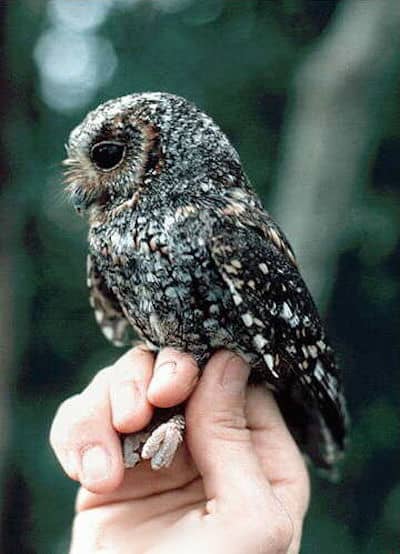The famous, face down, feet out sleeping position. A bit easier to see in the main post pic.
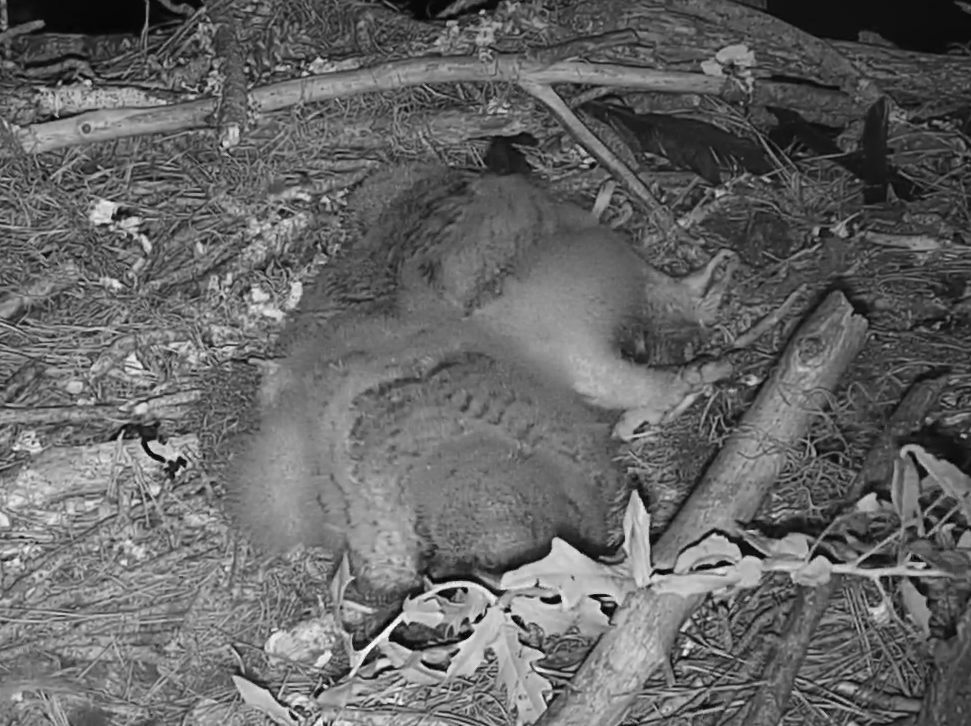
Comment on their development in feeding themselves. I saw Mrs Owl feeding both today, but it seems they should start doing it more on their own very soon.
Good evening, Ashton!! GHO owlets start to learn how to “self feed”, meaning grabbing on to the prey with their feet/talons, and shredding it, approx between 21 - 27 days old. HH5 is 22 days old and HH6 is 19 days old, and should in next week be able to start to “self feed”. If Dad or Mom pass a rodent directly to their beaks and it stays in, then they can swallow it. If there is prey already opened up with meat showing, they have just started to be able to “self feed” that way, by taking bites. Bayley has probably left the rodent there for them to try and figure out how to do it, and they won’t even try until they start to get hungry enough to try. This is how it is in all raptor nests when the parents leave the prey just laying there. Of course Bayley will still feed them, but she knows that they are now coming into that age now.
Timeline of when they will start to venture out of the nest:
The fledges will be approx 45 - 49 DAYS/March 21 - 25th, or approx 7 weeks. They still will be right around there and in their parents territory until FALL/WINTER. Bayley and Joshua will supplement feed them as they hone in on their hunting skills. At any time after “branching”, they could even “FLUDGE” where they “accidently fledged”. So it could be between 5 - 7 weeks that they are out of the nest tree. They are EXCELLENT climbers, though, and will be able to climb trees/bushes to hide, and where their parents will feed them wherever they are.
Nice image showing how high the nest is. Nesting is done between 15-45 ft / 4.5-14 meters off the ground. I haven’t seen a height given for this nest.

Bayley looks tired, lol.
It seems like having a combo of the fun of a newborn and a tween at the same time!
She’s getting more time to herself to leave the nest at least. Over the next few weeks, the parents will spend less and less time with them to get them used to owling on their own.
I was surprised by the one blurb of facts that said mom and dad will still help them out this coming winter. That’s much more generous than I expected, given then don’t even hang around each other during the rest of the year very much. Kinda thought they’d usher them off to find their own turf sooner, but that is nice they still help them through the first tough season on their own.
Big Feet!
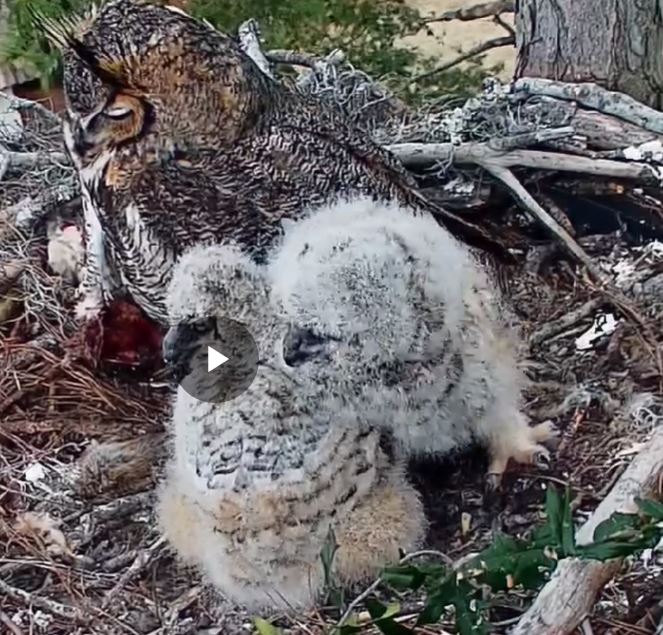
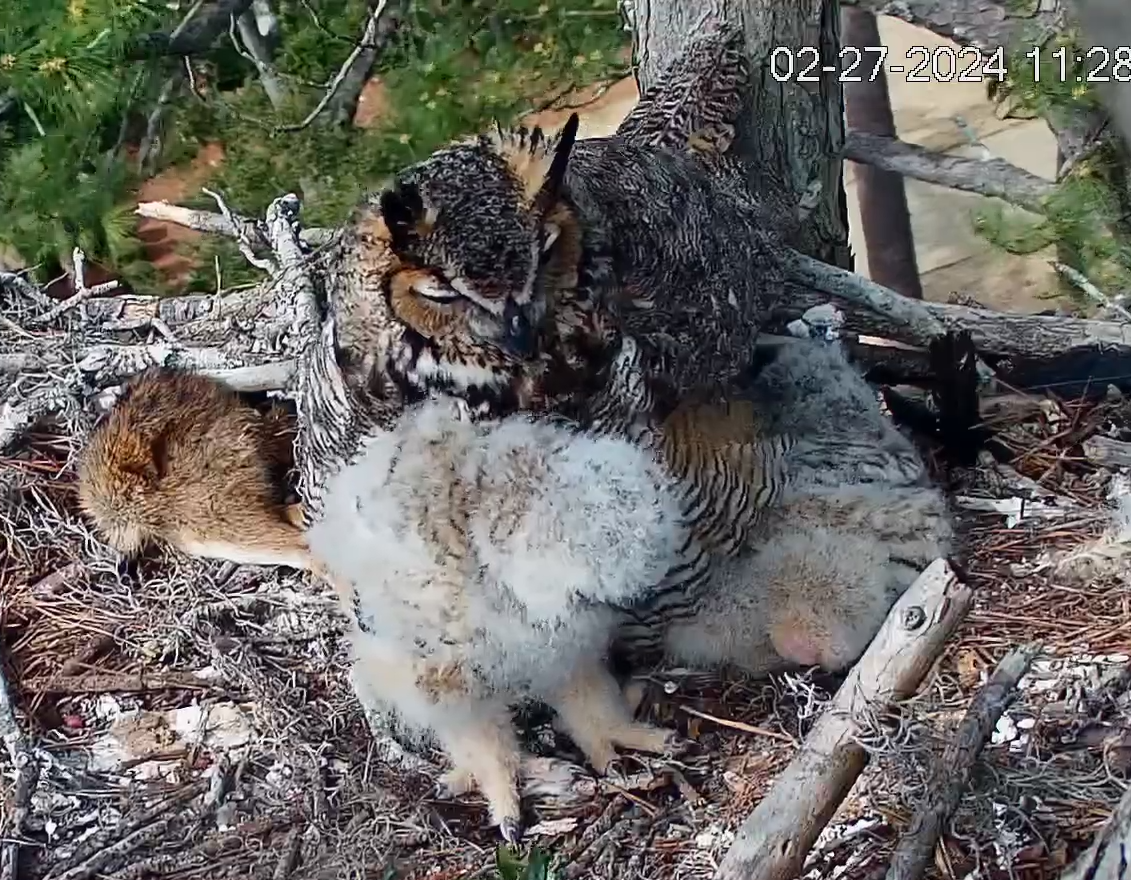
Taking a stretch here. I just missed grabbing a shot of it streching out both wings, and it look like it could about span half the nest! You can see the flight feathers really growing in.
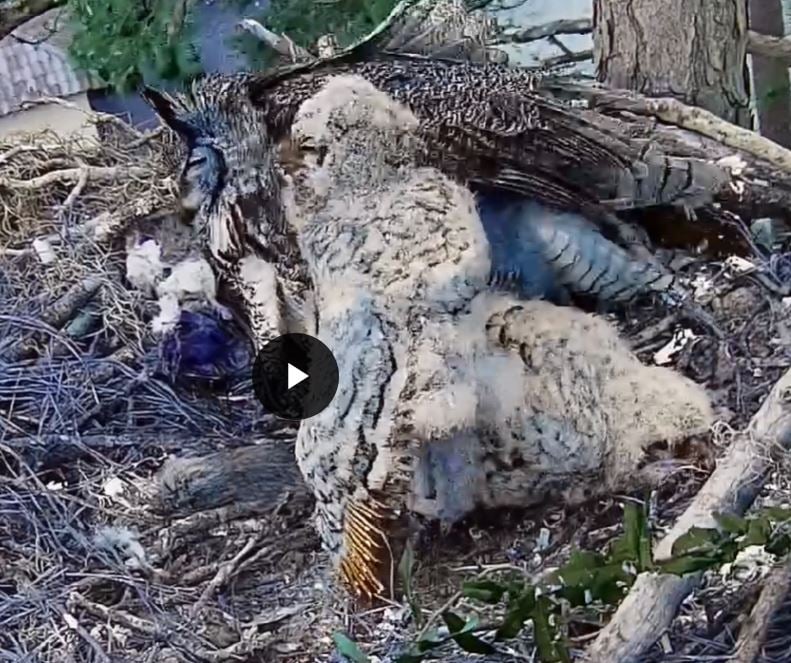
Look at its little wingtip feathers developing!
Growing feathers looks so uncomfortable, like when Wolverine’s claws come out. 😧
Reading about makes it sound relatively not bothersome, except maybe when the feather sheath gets pushed in a funny direction. They just seem to appear out of nowhere.
Copy pasta on GHO development:
Meadow HH5 is 22 DAYS OLD and HH6 is 19 DAYS OLD, heart
Here is the “GROWTH DEVELOPMENT”:
From “INTERNATIONAL OWL CENTER” site:
FEATHER DEVELOPMENT:
- 4-5 weeks: facial disc develops, flight feathers growing
- 5-6 weeks: fully developed black facial disc margin, flight feathers substantially grown
- 6-8 weeks: fledgling, wing feathers nearly fully grown but tails not quite done
- 3 months: adult breast feathers emerging
- 4 months: adult back feathers growing in
- 5 months: last of the adult head feathers growing in
- 6 months: fully feathered
From “BIRDS OF THE WORLD” site:
FEATHER DEVELOPMENT:
- Replacement of white downy plumage at hatching with immature (mesoptile) yellowish-white or grayish-buff, grayish- white plumage completed by day 8 (9, 13);
- Remiges and rectrices begin to rupture sheaths at 8 d,
- by 14 d >50% emerge (14).
- at 3 wk ear-tufts already show as small compact patches (15).
- by 14 d >50% emerge (14).
- Facial disc and white bib are well defined by 11 wk;
- mottled ochraceous buff coloring nearly complete by 21 wk;
- ear-tufts fully grown at 26 wk (15).
From “ALL ABOUT BIRDS/CORNELL LABS” site"
Day 19: The young will start trying to focus on objects with exaggerated head movements. Day 21: The young start to become more and more curious and begin to grasp objects in the nest and nibble them. Day 20-27: The owlets are able to feed themselves, with food brought to the nest, although the female parent may continue to feed them. Day 40: The young are able to climb well, at which time they may leave the nest and clamber out along a tree branch. This stage is known as branching. Day 45-49: The young are fully feathered and capable of flight. At seven weeks the owls are capable of three to four short flights of diminishing distance as they tire easily. After leaving the nest, the fledglings stick together for several weeks. They often roost together in a tree in the immediate vicinity. Adults generally roost away from the young, who react to the sight of the adults with begging calls and flights towards the adults.
TO ADD:
GHO parents will supplement feed their fledglings all the way into FALL/WINTER, as they hone in on their hunting skills. They can even still be around when Mom and Dad are into their next “courting season”. Eventually the fledglings will get that feeling to explore out - “DISPERSE” - off into other GHO owl territory boundaries, now called “FLOATERS”, until they one day meet their own mate and find their own territory. GHO’s are “SOLITARY BIRDS”, and once out on their own, do not get “lonely” before they find their mates.
Babies are getting so big, and their colors are starting to come in. They are about 6 inches / 15 cm right now. That’s the size of an adult Pygmy Owl or Flammulated Owl, and a bit shorter than a Burrowing Owl or Screech Owl.

Flammy for size reference:
